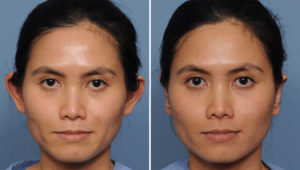Background: The most common congenital malformation of the external ears is that of excessive protrusion. Technically defined as the auriculo-cephalic angle, how open this angle is defines creates the appearance of ears that stick out too far. While the normal angle is up to 30 degrees, what really counts is the patient perception of their ear position. If the patient thinks their ears stick out too far, then they do.
Ear deformities are common with all ethnicities and genders. I have performed otoplasty correction on many different types of ethnic patients from Hispanic to Burmese. It does appear to be more common in Asians, presumably due to the increased bitemporal skull widths and less projecting occiputs. This may force the conchal position of the ear more outward.
While the fundamental components of an otoplasty to decrease the auriculo-cephalic angle are the same for all patients, the Asian otoplasty has a few anatomic issues to consider. Their thicker skin that is more prone to hypertrophic scarring makes the location and length of the incision important. Also their ear cartilages can be thicker with greater stiffness which may make them less easily moldable to a simple suture or two. Cartilage softening manuevers may be needed.
Case Study: This 30 year-old female had protruding ears all of her lift. She usually wore her hair down because of being self-conscious about their appearance.


Highlights:
1) Ear malformations are common amongst all ethnic groups although it may be more prominent in Asians due to their natural skull shape.
2) Otoplasty surgery for prominent ears in Asians must factor in their thicker skin and often stronger ear cartilages.
3) Asian otoplasty allows an increased emphasis on the face where angular and stronger skeletal features are more evident.
Dr. Barry Eppley
Indianapolis, Indiana


